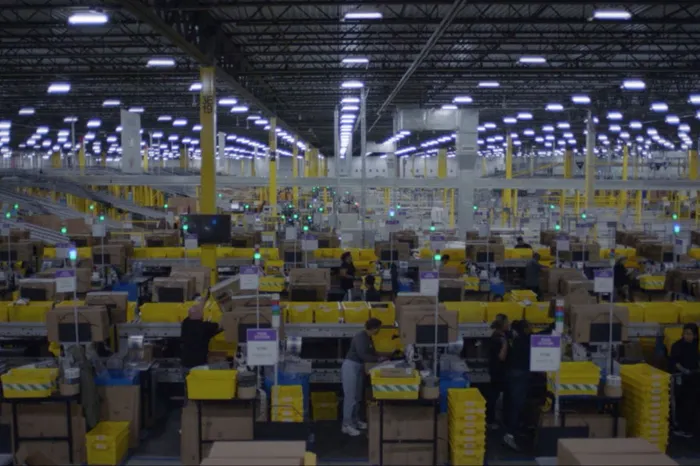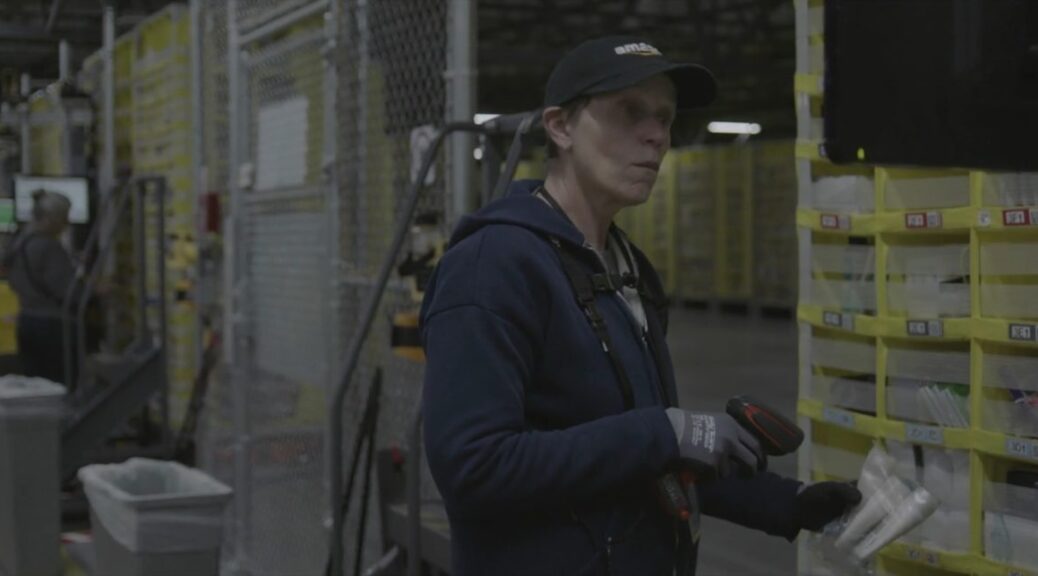In the twentieth century, the factory stood at the center of American life. Entire towns sprouted around them. Thanks to union-won wages, factory workers and their families could attain middle-class security. When I was writing a book about autoworkers, I kept hearing nostalgic stories of the way things used to be: however down on your luck you were, there was always a job waiting for you at the factory.
![]() After decades of companies offshoring manufacturing employment, the factory is no longer the institution it once was. The Amazon fulfillment center has taken its place. They’re everywhere where the online retailer ships its goods—which is everywhere in the world. A third of the country’s warehouse workers—700,000 people—work at Amazon facilities preparing the company’s goods for delivery. After her plant closes, Frances McDormand’s character in Nomadland does seasonal stints at Amazon warehouses while she roams the country by van. It’s become a cliché that Amazon is where you go if you want a job that pays more than the minimum, but that any able-bodied person can do.
After decades of companies offshoring manufacturing employment, the factory is no longer the institution it once was. The Amazon fulfillment center has taken its place. They’re everywhere where the online retailer ships its goods—which is everywhere in the world. A third of the country’s warehouse workers—700,000 people—work at Amazon facilities preparing the company’s goods for delivery. After her plant closes, Frances McDormand’s character in Nomadland does seasonal stints at Amazon warehouses while she roams the country by van. It’s become a cliché that Amazon is where you go if you want a job that pays more than the minimum, but that any able-bodied person can do.
That’s why it’s so troubling to read the research about how bad Amazon jobs have become. Take the findings of an academic survey released late last year, which drew from a nationally representative sample of Amazon warehouse workers. What comes across clearly is the true cost of getting your packages lightning fast. University of Illinois researchers found that four out of ten warehouse workers have been injured on the job. Half said they feel burnt out. And rather than lightening the load of its warehouse workforce, Amazon’s innovative use of technology appears to be at the root of these problems. Majorities of those reporting injuries or burnout said they felt a sense of pressure to work faster. Two-thirds said they had to take unpaid time off due to pain or exhaustion in the past month—which the study’s researchers link to the company’s algorithm-intensified pace on the floor.
Amazon, the country’s second-largest private employer, is known for paying better than Walmart, the largest, which sustains its low prices and low-wage workforce on a taxpayer-funded raft of tax credits, public health insurance, and food assistance. Because of this somewhat higher pay, Amazon’s warehouses continue to draw “nomads,” young people, and immigrants alike. Yet the frenetic pace of work on the floor breaks down Amazon’s workers physically and mentally, the research finds.
This bleak picture in the company’s warehouses illustrates just how much the livelihoods available to workers with less education have become bad—and not just in terms of poverty wages. Today, Americans are increasingly skeptical about the value of a college degree, pointing to high-paying skilled trades and other licensed occupations as alternatives. Yet the reality for most will look more like Amazon warehouse work: nasty, brutish, and short. That’s because of a decades-long decline in the quality of jobs available to those without college degrees, partly driven by the forms of automation and surveillance technologies that tech giants like Amazon have pioneered. This decline has been central to the cratering well-being of the country’s working class, who disproportionately suffer from the Amazon survey’s two headline findings—pain and burnout.
Over recent decades, the two-thirds of Americans 25 and older who lack bachelor’s degrees have seen their life chances veer away from those of the college-educated. Marriage rates have fallen. “Deaths of despair” caused by drugs, alcohol-related disease, and suicide have spiked. The estimated 100 million Americans in chronic pain largely hail from this group, whose suffering is now peaking in middle age rather than later in life—a trend not seen among the college-educated, or in other rich countries. Scholars have linked these outcomes to dwindling economic prospects. Importantly, the jobs to be had are not just lowly paid. As research has underscored, they have become bad across multiple dimensions—pay, benefits, advancement opportunities, and working conditions.

Technology was supposed to set workers free. In an automated workplace, machines would do the literal heavy lifting, and the humans would pick up whatever tasks remained. Fewer workers would be needed, but individual workers would be saved from backbreaking labor and exhausting repetition. But that doesn’t seem to be happening in Amazon warehouses. Yes, much work has been automated: Roomba-like robots trundle pods of goods across the floor, while packages glide across a complex network of conveyor belts. But humans are still needed to pick and count the items for packaging, among other things. And here, Amazon’s use of technology isn’t about liberating workers, but disciplining them.
At the company’s fulfillment centers, workers scramble to prepare packages, walking “up to 13 miles a day” and lifting “a total of 20,000 pounds” during each shift, according to a company pamphlet. To keep them moving, Amazon tracks workers whenever they scan goods, penalizing them when they are not scanning. That frenzied pace appears to be taking a toll. In their national scientific sample of Amazon workers, researchers Beth Gutelius and Sanjay Pinto found that half had experienced moderate or severe pain in their leg, knee, or foot in the last three months. Half reported physical exhaustion. Amazon’s algorithmic Taylorism appears to be connected to these problems, with those raising concerns about keeping up and going without breaks more likely to report injuries.
Christine Manno left a clerical job to work at STL8, an Amazon fulfillment center in the St. Louis area, because she was tired of sitting at a desk. But timed trips through the warehouse to pull dozens of items—each selected by algorithm—left her “exhausted all the time.” “Some of the symptoms are slower to show up,” said Manno, 56, a member of the STL8 Organizing Committee, a group of workers fighting for better pay and conditions and the right to form a union at the warehouse. After a 12-hour shift pulling printer-paper boxes and cat litter from 30-foot-high shelves, her hands would become numb. After two years, her wrists developed stabbing pains and ended up needing surgery.
Of injured Amazon workers, a third said on the survey they had not reported their injury—a quarter of them because of worries they would “face negative consequences.” Survey responses also suggest that the company’s first-aid clinics are delaying and refusing treatment and discouraging workers from seeking outside care, possibly pushing down the injury numbers—which are already much higher than those of other warehouse employers.
Factories, of course, were not particularly safe or enjoyable places to work even when they employed large segments of the working class, as protests over working conditions at auto plants famously highlighted in the 1970s. But that is the problem with today’s bad jobs: they no longer even make up for their misery. As tough as factory life was, workers stayed for the high pay and pensions, which offered realistic hopes for middle-class livelihoods and better prospects for their kids. Nowadays, Amazon has such extreme turnover that a leaked 2022 company memo warned it was running out of workers.
The widespread reports of pain at Amazon also bring to mind the country’s epidemic of chronic pain, which is concentrated among the working class and linked to a mix of socioeconomic factors. Generally speaking, U.S. workplaces have become safer for those with and without college degrees. That said, workers do not have to experience acute injuries to damage their bodies over the long term. Wear and tear now can lead to chronic pain and disability later. It is notable that many injuries disclosed on the Amazon survey were repetitive-motion injuries, which can be slower to emerge and harder to connect to the workplace.
Of course, Amazon’s hard-driving culture ensures packages get delivered on time. And that’s the underlying reason that working-class jobs are so bad. Without unions or regulators pushing back, low-margin companies have incentives to push their workers—scientifically, algorithmically—to their breaking point. But if this is the work that the country’s largest employers are offering, no wonder so many in the working class are physically and mentally shut down. They just don’t make jobs like they used to.
Victor Tan Chen Victor Tan Chen is In The Fray's editor in chief and the author of Cut Loose: Jobless and Hopeless in an Unfair Economy. Site: victortanchen.com | Facebook | Twitter: @victortanchen
- Follow us on Twitter: @inthefray
- Comment on stories or like us on Facebook
- Subscribe to our free email newsletter
- Send us your writing, photography, or artwork
- Republish our Creative Commons-licensed content

